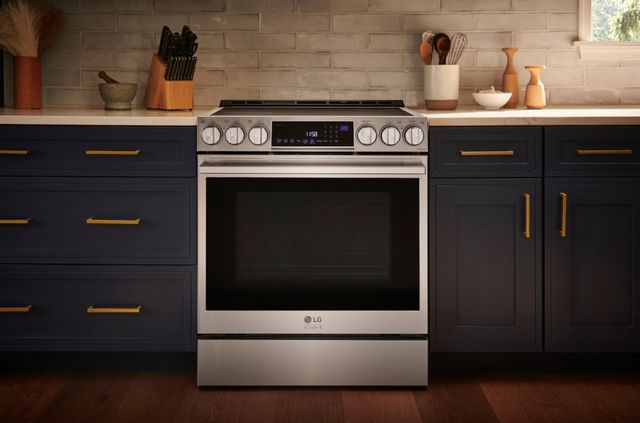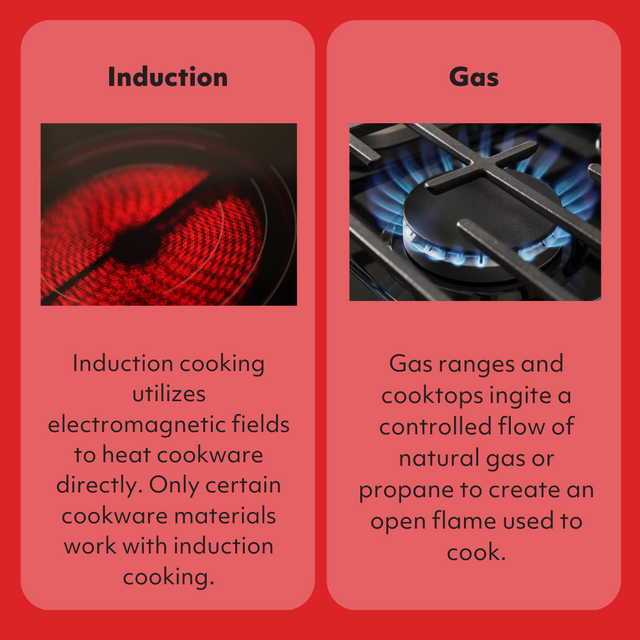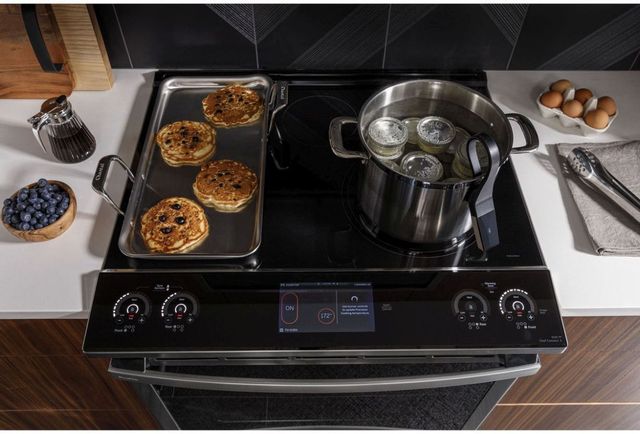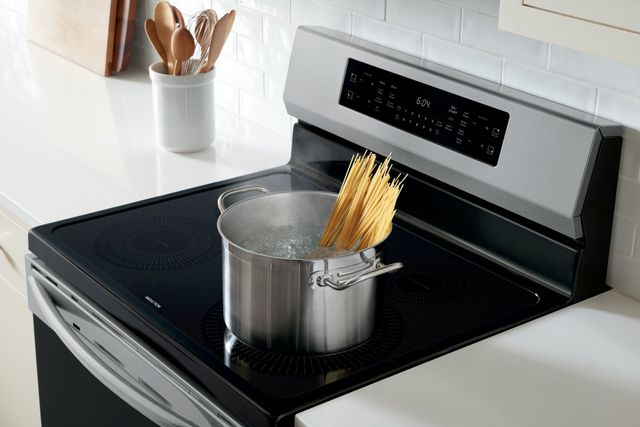
At a Glance:
Induction vs Gas: What's the Difference?
How Common Is It to Have an Induction Range vs Gas Range
Which is Right for You: Induction vs Gas
Calling all home chefs everywhere to prepare for the debate: is induction better than gas? This question may spark some heated debates, with many preferring one over the other.
Some say induction cooking is cleaner for the environment and saves more energy. However, some enthusiastic chefs may claim that gas cooking gives them more control, with more natural and precise results.
With so many myths surrounding induction stove vs gas, it's time to break down the pros and cons of induction vs gas and find out the answer to the highly curious question, "Is induction better than gas?"
Explore Cooking Appliances at Arnold's
Need a new cooktop or range? Explore induction, electric, and gas options available at Arnold's Appliance, today!
Shop All Ranges & CooktopsInduction vs Gas: What's the Difference
An induction stove contains an induction cooktop that works with electromagnetic coils. These coils transfer heat directly into metal items. Induction stoves and their cooktops may look the same as a regular electric ones but function differently.
An electric range's heat source is centralized. The surface of an electric stove is either glass or ceramic, and beneath the surface are metal coils. An electric current heats these coils, slowly transferring heat to the surface via infrared energy. That energy heats the burner's surface, cooking the food inside the pot or pans you place on the cooktop by thermal conduction.

An induction cooktop is also electric but with a different heating process. There are copper coils in an induction stove, creating not an electric current but a magnetic one. This magnetic current does heat the cookware through the surface. Instead, it heats the cookware directly. As a result, your cookware retains more heat quickly and evenly.
As you can imagine, a gas stove is not electric at all. It's powered by natural gas that produces flame to heat and cook your food. Until now, many people still considered cooking with gas would yield more precise cooking because you can control your flame and make real-time adjustments. More traditional chefs may prefer this method because cooking this way may seem more authentic or more sensual.
And because an induction cooktop heats with magnetic waves, the cookware must be compatible. Conductive pots and pans (made from stainless steel or cast iron) work best with an induction cooktop. Meanwhile, there's no unique cookware needed for gas cooktops. As long as it can withstand high heat, you can use any ceramic or glass cookware.
How Common Is It to Have an Induction Range vs Gas Range
Induction stoves and cooktops are highly prevalent in Europe, where they have gained widespread adoption due to their energy efficiency, precise temperature control, and safety features. In many European countries, induction technology is favored over traditional gas or electric stoves for its faster heating times and cleaner cooking experience. Additionally, induction cookware is readily available, making it easier for consumers to transition to this innovative cooking method. As a result, induction stoves and cooktops have become a standard choice in European kitchens, reflecting the continent's commitment to sustainability and technological advancement in the culinary realm.

Here in the US, though, we see a different story. More than a third of Americans in the US still use gas ranges. The New York Times reports that 40 million home cooks use gas stoves domestically. One reason gas ranges are still prevalent is their price and affordability. Their much lower price maintains their popularity among Americans. Massachusetts also has a relatively high number of gas stove users (around 44%). Meanwhile, the number is lowest—under 10%—in Maine.
However, one report says that a third of Americans have yet to hear about an induction cooktop, and only a tiny percentage (3%) have an induction range. Because of this room for growth, we can expect Americans to begin to adopt induction cooking in their homes. The market for induction cooking in North America can anticipate an 8% annual growth, with the global market capable of reaching 36 billion dollars by 2028.
Is Induction Better than Gas: An Analysis
Eventually, due to the government's clean-energy initiatives, induction ranges may replace gas ranges entirely in many American homes. For example, natural gas has been outlawed in new constructions in New York City, resulting in new buildings not having gas lines. These buildings will naturally have to find 'greener' cooking alternatives, including using induction ranges. Many states are also working on similar rules.

Let's examine its natural benefits to prepare yourself for switching from gas to induction cooking.
✅ Better air quality: Induction ranges produce cleaner air inside a home, thus it is much better for the environment. The induction technology reduces smoke and toxic fumes. Although having good ventilation and air conditioning can still benefit a home, the need is less urgent with induction ranges.
✅ Higher safety level: Because there's no flame involved in induction cooking, there's less chance of anything burning. If you're momentarily distracted, there are fewer risks involved with the induction cooktop.
✅ Energy saving efficiency: Heat distribution is more efficient and controlled with induction stoves. The result is more powerful heat but more energy efficient because no heat is lost during the transfer. With induction cooking, the cookware is the only thing that heats up, not the surface or the air around the cookware.
✅ Quicker cooking time: Some chefs find that induction cooking promotes quicker and more consistent cooking times. It heats foods and water twice more rapidly than gas. Plus, choosing a specific temperature and maintaining it throughout is easier. When the burner is turned off, the heat instantly stops transferring, with little chance of overcooking.
✅ Smoother cleanup: Cleaning an induction stove is easier because there are fewer knobs and burners to scrub. The surface stays cool so any residue won't stick and burn and can be wiped down.
✅ Government rebates: In 2023, the US government enacted the Inflation Reduction Act. This act gives households rebates for installing energy-saving electric appliances, including induction stoves.
Gas vs Induction: Comparison
Let's directly compare gas range vs induction range to get the definitive answer to the question "Is induction better than gas?"
| Aspects for Comparison | Induction Stove | Gas Stove |
|---|---|---|
| Appearance | Modern and sleek design with glass and smooth top surfaces. Most models have circles to indicate where the cookware goes. | Industrial design with stainless steel top and aluminum layers. Gas ranges have burner grates elevated over the countertop. Most gas ranges look bulky and sturdy. |
| Cookware | Unique cookware is required. Cast iron, enameled cast iron, and (most) stainless steel pots and pans will work. | Aluminum, copper, glass, works, and ceramic cookware can be used for gas ranges. However, they will only work for induction ranges if an induction plate is on the base. |
| Care and maintenance | Accessible with a flat surface and no indents or crevices. Cleanup is available with simple homemade ingredients like cleaning vinegar and baking soda. | It's more complicated. The gas tank must be refilled, the burner grates must be removed before cleaning, and the stove has more notches and grooves. |
| Cost | Induction units can be more expensive, ranging between $1,000 and $2,500, but their operational cost may be lower. | Gas units are often cheaper than induction, ranging between $300 and $1,500. However, the operational cost is bound to be higher. |
| Energy efficiency | Induction stoves don't produce a lot of smoke or toxic fumes, so there is no need for extra ventilation or air cooling. | Gas stoves produce plenty of smoke and emit greenhouse gases, so a good range hood is necessary. |
| Resale value | Homes with an induction range have a high resale value for modern and environmentally conscious homeowners. | A gas range may lure in traditional homeowners who like cooking with fire. |
Like it or not, induction stoves have more edge than gas stoves. There are no defeating induction cooktops for saving energy, providing cleaner indoor air quality, and more accessible care and maintenance. Perhaps the most significant case against an induction stove is replacing your regular cookware with induction-compatible ones and the initial purchase price.
Which Is Right for You: Induction vs Gas

So, which one should you choose between an induction cooktop vs gas? What about an induction range vs gas? The answer is still not as straightforward as you may think, even after comparing both cooktops. It all comes down to your cooking habits, needs, preferences, and budget.
Go for an induction if you:
- Want precise temperatures
- Quicker cooking times
- Cleaner air at home (particularly if you have children)
But you can instead go for gas if you:
- Like having a clear visual of the flames
- You already installed a gas stove, and it still works fine
- Lack of the budget to make the change
While we can say yes to "Is induction better than gas?" the choice still ultimately falls to you, as the homeowner, to decide which appliance will serve you better. Perhaps browsing your favorite appliance store and looking at the options can help you weigh in more carefully.
→ Learn more: Cafe Induction Range Review
FAQ
Is induction better than gas?
The above comparison table shows that induction stoves have a slight advantage over gas stoves. Chief among their benefits are energy efficiency and more accessible care and maintenance.
Can I use cast iron on induction stoves?
Yes, you can. Cast iron pans are suitable for use on induction stoves.
How can I clean up an induction cooktop?
First, scrape food and oil residue from the surface. Spray some cleaning or homemade vinegar and baking soda solution on the surface. Then, wipe the surface with a soft cloth or cleaning pad. You can also use a special cleaner for glass or ceramic on the surface. Use a dry cloth to polish.
Where can I find induction cookware near me?
You can search for "induction stove near me" or "induction cookware near me" online. Or, if you already have a trusted store, such as Arnold's Appliance, you can see the available models and compatible cookware.
→ Learn more: 8 KitchenAid Stoves Compared
Why Trust Arnold’s Appliance?
Arnold's Appliance started in the summer of 1956 when it opened its doors as Lakeshore Appliance in Redmond, Washington. John Arnold and his family have since grown the store from just a few brands to the large appliance store it is today and moved to Bellevue in 1999 in search of a larger building. Arnold’s Appliance now offers high-end innovative products from over 45 manufacturers.
In addition to extensive product knowledge, Arnold’s has been providing fine appliances to Northwest builders, remodelers, designers, architects, and developers for over 47 years. Arnold's supplies products and installation to many of the finest custom and spec home builders in the Pacific Northwest. Along with single-family housing, Arnold's has also supplied products for some of the largest multi-unit projects in the area. Arnold’s, now the third generation of the Arnold Family, is dedicated to bringing the best quality products, delivery services, and installation to customers for years to come.
Shop Induction at Arnold’s Appliance
Stop by Arnold’s Appliance Bellevue, WA location to see what a difference buying locally with an experienced staff can make. Or shop induction ranges online! Our friendly experts are always happy to help you answer the question, "Is induction better than gas?" — whether you call us at 425-454-7929, use our online chat feature, or visit us in person.
→ Learn more: 36-Inch Electric Cooktops: 6 Best Reviewed Models